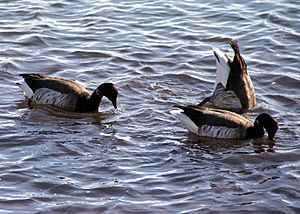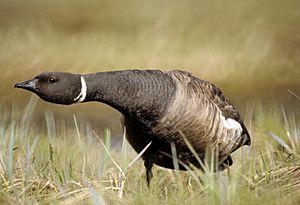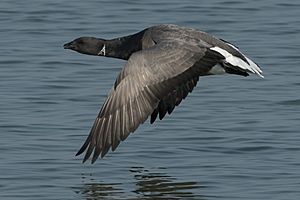Brant (goose) facts for kids
Quick facts for kids Brant (goose) |
|
|---|---|
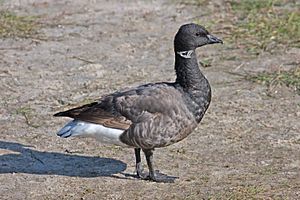 |
|
| Conservation status | |
| Scientific classification | |
| Genus: |
Branta
|
| Species: |
bernicla
|
 |
|
| Global map of reports to eBird Year-Round Range Summer Range Winter Range | |
| Synonyms | |
|
Anas bernicla Linnaeus, 1758 |
|
The brant or brent goose (Branta bernicla) is a small goose that belongs to the Branta group. These geese spend their winters along the coasts in warmer areas. They travel to the high-Arctic tundra to breed.
Did you know that the Brent System, a large oilfield, was named after this goose?
Contents
What Does a Brant Goose Look Like?
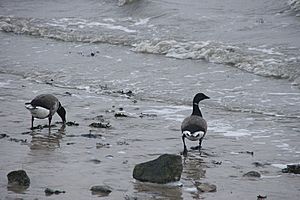
The brant goose is a small goose with a short, thick beak. It is about 55 to 66 centimeters (22 to 26 inches) long. Its wings can spread 106 to 121 centimeters (42 to 48 inches) wide. These geese weigh between 0.88 and 2.2 kilograms (1.9 to 4.9 pounds). Their tail is black and very short. The feathers under their tail are pure white.
There are three main types, or subspecies, of the brant goose:
- Dark-bellied brant (B. b. bernicla)
- Pale-bellied brant (B. b. hrota)
- Black brant (B. b. nigricans)
Scientists have looked at their DNA. This shows that these three types are genetically different. Some people think they should be separate species. However, most scientists still consider them all to be one species.
Dark-bellied Brant
The dark-bellied brant has a body that is mostly dark grey-brown. Its sides and belly are not much lighter than its back. Its head and neck are black. It has a small white patch on each side of its neck.
About 250,000 dark-bellied brant geese exist. They breed on the Arctic coasts of central and western Siberia. In winter, they fly to western Europe. More than half of them spend winter in southern England. Others are found between northern Germany and northwestern France.
Pale-bellied Brant
The pale-bellied brant looks blackish-brown and light grey. Its body has different shades of grey-brown. Its sides and belly are much lighter than its back. This creates a clear contrast. Like the dark-bellied brant, its head and neck are black. It also has a small white patch on each side of its neck.
There are about 250,000 pale-bellied brant geese in total. The largest group breeds in northeastern Canada. They spend winter along the Atlantic coast of the U.S. from Maine to Georgia.
Two smaller groups also exist. One group breeds in Franz Josef Land, Svalbard, and northeastern Greenland. They winter in Denmark, northeast England, and Scotland. The other group breeds in the far-northeastern Canadian islands. They winter in Ireland, southwest England, and a specific area in northern France. In Ireland, you can see them in places like Lough Foyle and Strangford Lough.
Black Brant
The black brant looks blackish-brown and white. This type of goose has very strong black and white colors. Its back is a dark sooty-brown. Its underside is also dark. It has a bright white patch on its sides. It also has larger white patches on its neck, almost forming a full collar.
About 125,000 black brant geese exist. They breed in northwestern Canada, Alaska, and eastern Siberia. Most of them spend winter on the west coast of North America. This stretches from southern Alaska to California. Some also winter in east Asia, mainly Japan. Their population has changed over time, from about 200,000 in 1981 to 100,000 in 1987.
Some scientists once thought that black brant geese from Asia were a separate type. However, it is now believed they are the same as the B. b. nigricans type.
Gray Brant
There is also a fourth type of brant goose. It is sometimes called the gray brant or intermediate brant. These birds breed in central Arctic Canada, mainly on Melville Island. They spend winter on Puget Sound near the U.S./Canada border.
These geese look like a mix between black brant and pale-bellied brant. They have brown upper parts and grey underparts. This makes the white patch on their side less noticeable. Some scientists think they might be a mix of the other two types.
When not breeding, brant geese usually stay in small family groups. They tend to stick with others of their own type. However, sometimes different types can be found in the same areas.
Where Do Brant Geese Live and What Do They Eat?
In winter, the brant goose used to live only along the coast. They rarely left the tidal estuaries. There, they would eat eelgrass (Zostera marina) and a type of seaweed called sea lettuce (Ulva).
On the east coast of North America, their diet changed. In 1931, a disease affected the eelgrass. This almost wiped out the brant geese. The few that survived started eating sea lettuce instead. This helped them survive until the eelgrass grew back. Brants have continued to eat sea lettuce since then. A similar problem with eelgrass in Ireland in the 1930s also hurt their population.
In recent years, brant geese have started using farmland a bit inland. They eat a lot of grass and winter-sown cereals. Some people think they learned this by watching other types of geese. Also, there might not have been enough food in the estuaries. The world population of brant geese grew a lot, reaching 400,000-500,000 by the mid-1980s. This might have made them look for new food sources.
During the breeding season, they live in low, wet coastal tundra. They use this area for both breeding and eating. Their nest is shaped like a bowl. It is lined with grass and soft feathers. Nests are often found in higher spots, usually near a small pond.
The brant goose is part of an important agreement. It is called the Agreement on the Conservation of African-Eurasian Migratory Waterbirds. This agreement helps protect birds that migrate.
What's in a Name?
The name Branta comes from an Old Norse word, brandgás. This means "burnt (black) goose." The word bernicla is a medieval Latin name for the barnacle.
Long ago, people thought the brant goose and the similar barnacle goose were the same species. They even believed these geese were the same creatures as the crustacean barnacles! This myth goes back to at least the 12th century.
Some people claimed to have seen these birds hanging from pieces of wood. Others said they saw the birds coming out of their shells. This legend lasted until the late 1700s. In County Kerry, Ireland, Catholics could even eat this bird on Fridays. They counted it as fish because of the old belief!
See also
 In Spanish: Barnacla carinegra para niños
In Spanish: Barnacla carinegra para niños



